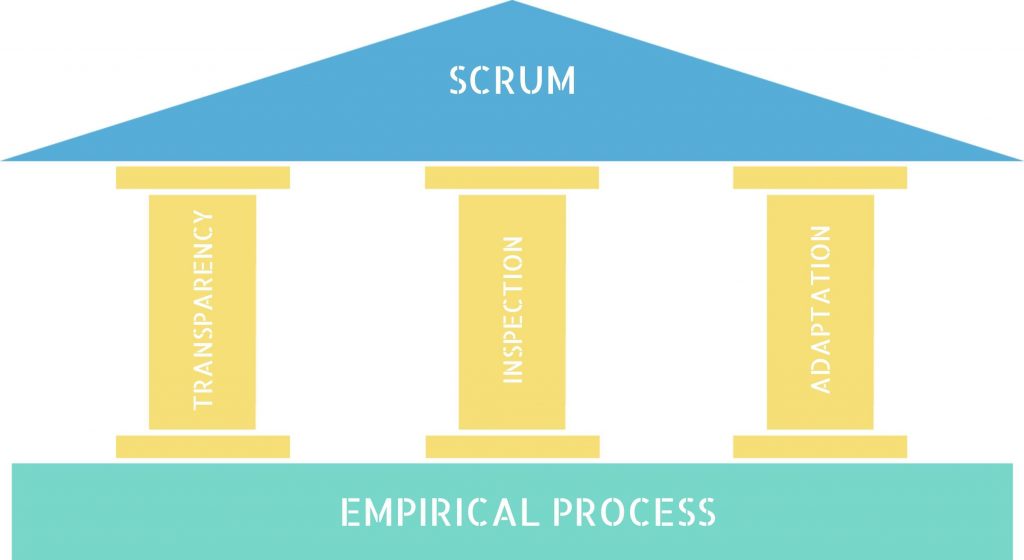
Three pillars that make your IT project move toward success
Let’s take a deeper look at three pillars of Scrum and how it applies the IT project management.

Let’s take a deeper look at three pillars of Scrum and how it applies the IT project management.
Let’s take a second to guess what the author meant and if we can apply it to our IT project management workflow. Well, in the ideal scenario, we would have specified guiders, everyone could use, so each project would be finished on time without any trouble and be within the scope and budget. As we know, that is the ideal model, though it lands far away from reality.
Speaking of pillars, what those could be? A large budget, unlimited time, or the most experienced developers? What about the vast amount of detailed documentation of requirements? Or last but not least, a project management genius?
All of the above factors are important, but without the mentioned three pillars, they might not mean that much.
For those who heard about Scrum, this part is relatively easy to figure out. Three pillars that make the IT project move towards success are transparency, inspection, and adaptation. Scrum guide describes this approach well. However, we can also apply it to other management practices.

In the waterfall methodology, we can easily find a resemblance to monitoring, predicting the risk, and solutions for managing problems when they appear. However, it is transparency that is the central pillar, and this one is mostly related to communication standards. In other methodologies, there is no such impact on transparency than we put in Scrum. There are documentation, reports, statuses, and they all are essential practices. Nevertheless, they are different from the definition of transparency itself.
Clear communication and vision is the first step towards success. What about the mentioned transparency? Lack of transparency blocks the inspection process, and without an inspection, we have no adaptation. Without adaptation, we maximize the probability of failure. That is the main argument for the importance of transparency.
That is what Scrum Guide says about transparency:
Significant aspects of the process must be visible to those responsible for the outcome. Transparency requires those aspects to be defined by a common standard so observers share a common understanding of what is being seen.
For example:
However, additional actions are hiding between those lines.
The goal should be crystal clear for the team and the same as the client’s goal. That is why language should be unified and simple, so everybody understands the vision we share. This way, we also decrease the number of misunderstandings while talking about the project.
So, transparency is not only crucial for the project team but also for everyone involved in the whole process, product, especially the client and end-users.
The second pillar means we need to keep verifying if we are staying on the right track. In the real world, we do not have any clarified success map, but each time we take a step, we discover more of it and get hits about what direction to go at the moment. Inspection is a checkpoint of some kind. It could be a meeting with the client, a team meeting, or a demo. Following the Scrum philosophy, we should be doing it frequently enough to make sure we discover all the pieces of the map and not omit any of them. The team should do an iterative inspection. If there is more than one goal to achieve, one check would not be enough.
I’d like to refer to Mark Noneman’s speech about empiricism.

He explains what empiricism theory is about using the example of a thermostat at its core. A thermostat inspects the temperature frequently enough to keep it under control. If it detects the temperature is too high, it starts continuously cooling it down. However, the period between the last and next inspection can not be too long, because the thermostat won’t stop cooling until the appropriate temperature gets reached. Instead, it will be cooling until the next iteration. Therefore it overlooks and could not meet its goal.
The most important thing at this point is to check frequently enough what is happening inside the project. The next pillar is the answer to what we find out.
Successful adaptation is about continuous improvement. Once our inspection gets done, we have a better idea of where we are standing, and if we are closer to achieving the goal.
The next step, adaptation, is based on the results of our inspection. So, it is essential to put this simple question on the table daily: are we better than yesterday? If so, what have we done to achieve it? Adaptation should be frequent the same as inspection. Those two are strongly connected. Once we find weaknesses during the inspection, let’s make a plan of our adaptation and put it into practice. This practice helps to facilitate the process and avoid the same problems in the future.
If everything works fine, adaptation is the opportunity to focus on what we can do even better. For instance, we can make improvements such as faster time to market, higher revenue, or the users of our product who get happier. Everything that brings us value we should take into consideration for improvement.
Three pillars of empiricism are worth implementing in every project, especially in innovative ones. By providing transparency, frequent inspection, and adaptation, we make our IT projects move toward the goal. These pillars are essential for each member of the team. By achieving them means not only the success of the project but, most of all, the success of our whole team.
 Hi, I’m Marcin, COO of Applandeo
Hi, I’m Marcin, COO of Applandeo
Are you looking for a tech partner? Searching for a new job? Or do you simply have any feedback that you'd like to share with our team? Whatever brings you to us, we'll do our best to help you. Don't hesitate and drop us a message!
Drop a message